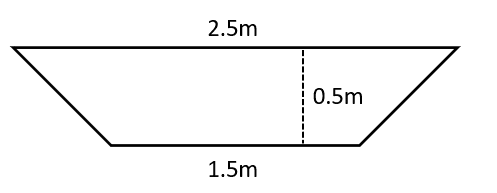Applications of Differentiation
Applications of Differentiation Revision
Applications of Differentiation
In this section, we’ll look at how to use differentiation in mechanics and practical problems.
Make sure you are happy with the following topics before continuing.
Finding Maximum and Minimum Values of Volume and Area
We can use differentiation to find optimal values of dimensions of objects.
So, let’s say wish to create a hollow box of length 2\textcolor{blue}{x}, width \textcolor{blue}{x} and height \textcolor{purple}{h}, and we have a limit of 600\text{ cm}^2 of wood to use.
To find the maximum volume possible, we must find two equations in volume and area:
\textcolor{red}{V} = 2\textcolor{blue}{x} \times \textcolor{blue}{x} \times \textcolor{purple}{h} = 2\textcolor{blue}{x}^2\textcolor{purple}{h}
and
\textcolor{limegreen}{A} = 2(2\textcolor{blue}{x} \times \textcolor{blue}{x}) + 2(2\textcolor{blue}{x} \times \textcolor{purple}{h}) + 2(\textcolor{blue}{x} \times \textcolor{purple}{h}) = 4\textcolor{blue}{x}^2 + 6\textcolor{blue}{x}\textcolor{purple}{h} = 600
Of course, we only want to differentiate in terms of one variable, so we’ll transform the second equation to \textcolor{purple}{h} = \dfrac{300 - 2\textcolor{blue}{x}^2}{3\textcolor{blue}{x}}
Plugging this back into our equation for \textcolor{red}{V}, we have
\textcolor{red}{V} = \dfrac{2\textcolor{blue}{x}^2(300 - 2\textcolor{blue}{x}^2)}{3\textcolor{blue}{x}} = 200\textcolor{blue}{x} - \dfrac{4\textcolor{blue}{x}^3}{3}
We can then differentiate with respect to \textcolor{blue}{x} to find the maximum volume of the box:
\dfrac{d\textcolor{red}{V}}{d\textcolor{blue}{x}} = 200 - 4\textcolor{blue}{x}^2 = 0, giving \textcolor{blue}{x} = \sqrt{50}
We must also verify that this is a maximum, rather than a minimum, so we find \dfrac{d^2\textcolor{red}{V}}{d\textcolor{blue}{x}^2}:
\dfrac{d^2\textcolor{red}{V}}{d\textcolor{blue}{x}^2} = - 8\textcolor{blue}{x} = -8\sqrt{50} < 0, so this is definitely a maximum point.
Therefore, we have \textcolor{blue}{x} = \sqrt{50} and \textcolor{purple}{h} = \dfrac{200}{3\sqrt{50}}, giving \textcolor{red}{V}_{max} = \dfrac{20000}{3\sqrt{50}}.
Finding Rates of Change in Mechanics
In Mechanics, we’ll talk about the derivation of acceleration and velocity from displacement.
From the displacement \textcolor{limegreen}{s}, we can differentiate with respect to \textcolor{purple}{t} to find \textcolor{red}{v}, and differentiate again to find \textcolor{blue}{a}.
So,
\dfrac{d\textcolor{limegreen}{s}}{d\textcolor{purple}{t}} = \textcolor{red}{v}
and
\dfrac{d^2\textcolor{limegreen}{s}}{d\textcolor{purple}{t}^2} = \dfrac{d\textcolor{red}{v}}{d\textcolor{purple}{t}} = \textcolor{blue}{a}
So, for example, let’s say we have an equation for the displacement \textcolor{limegreen}{s} = 2\textcolor{purple}{t}^3 - 3\textcolor{purple}{t}^2 -4\textcolor{purple}{t} + 1.
We can find an equation for the velocity:
\textcolor{red}{v} = 6\textcolor{purple}{t}^2 - 6\textcolor{purple}{t} - 4
and an equation for the acceleration:
\textcolor{blue}{a} = 12\textcolor{purple}{t} - 6
Therefore, we can find the values of \textcolor{purple}{t} such that \textcolor{red}{v} = 0:
6\textcolor{purple}{t}^2 - 6\textcolor{purple}{t} - 4 = 0 has solutions at \textcolor{purple}{t} = \dfrac{1}{2} \pm \sqrt{\dfrac{11}{12}}, but we cannot have a negative time, so we have \textcolor{purple}{t} = \dfrac{1}{2} + \sqrt{\dfrac{11}{12}}.
\textcolor{blue}{a} = 12\left( \dfrac{1}{2} + \sqrt{\dfrac{11}{12}}\right) - 6 = 11.49, so we can conclude that this is a point of minimum displacement.
Applications of Differentiation Example Questions
Question 1: Find the maximum volume possible when we create a hollow box of length 5x, width 3x and height h, and we have a limit of 30000\text{ cm}^2 of wood to use.
[5 marks]
To find the maximum volume possible, we must find two equations in volume and area:
V = 5x \times 3x \times h = 15x^2h
and
A = 2(5x \times 3x) + 2(5x \times h) + 2(3x \times h) = 30x^2 + 16xh = 30000
Of course, we only want to differentiate in terms of one variable, so we’ll transform the second equation to
h = \dfrac{30000 - 30x^2}{16x}
Plugging this back into our equation for V, we have
V = \dfrac{15x^2(30000 - 30x^2)}{16x} = 28125x - 28.125x^3
We can then differentiate with respect to x to find the maximum volume of the box:
\dfrac{dV}{dx} = 28125 - 84.375x^2 = 0, giving x = \sqrt{\dfrac{1000}{3}}
We must also verify that this is a maximum, rather than a minimum, so we find \dfrac{d^2V}{dx^2}:
\dfrac{d^2V}{dx^2} = - 168.75x = -168.75\sqrt{\dfrac{1000}{3}} < 0, so this is a maximum point.
Therefore, we have x = \sqrt{\dfrac{1000}{3}} and h = \dfrac{20000}{16\sqrt{\dfrac{1000}{3}}}, giving V_{max} = \dfrac{6250000\sqrt{3}}{\sqrt{1000}}.
Question 2: A firework is fired directly upwards and has a height of h = 1000\left( \dfrac{t^2}{40} - \dfrac{t^3}{600}\right). Find the time t when the firework finds its maximum height, and state this height.
[4 marks]
h = 1000\left( \dfrac{t^2}{40} - \dfrac{t^3}{600}\right) gives
\dfrac{dh}{dt} = 1000 \left( \dfrac{t}{20} - \dfrac{t^2}{200}\right)
and
\dfrac{d^2h}{dt^2} = 1000 \left( \dfrac{1}{20} - \dfrac{t}{100}\right)
Setting \dfrac{dh}{dt} = 0 gives 1000\left( \dfrac{t}{20}\left( 1 - \dfrac{t}{10}\right) \right) = 0, meaning that t = 0 or t = 10.
Using t=10 gives h=833\text{ m}.
Question 3: Let a bath be modelled as a trapezium with the dimensions shown in the diagram, and width 1\text{ m}. Assuming that water occupies a volume of \dfrac{1}{2}t^2 + 4t\text{ cm}^3, find the amount of time it takes for the bath to fill completely, and find the rate that the water is filling the bath at this point.
[5 marks]

Volume of bath, V:
V = \dfrac{1}{2}(2.5 + 1.5) \times 0.5 \times 1 = 1\text{ m}^3 = 1 \times 10^6 \text{ cm}^3
Then, we must find t such that \dfrac{1}{2}t^2 + 4t - 1000000 = 0.
Using the quadratic formula, we have
t = \dfrac{-4 \pm \sqrt{16 - \left( 4 \times \dfrac{1}{2} \times -1000000 \right)}}{1} = -1418.22, 1410.22\text{ s}
So, we know that the bath takes approximately 23.5\text{ minutes} to fill.
When t = 1410.22, \dfrac{dV_{filled}}{dt} = t + 4, so the water is filling the bath at a rate of 1414.22\text{ cm}^3\text{ s}^{-1}.
You May Also Like...

MME Learning Portal
Online exams, practice questions and revision videos for every GCSE level 9-1 topic! No fees, no trial period, just totally free access to the UK’s best GCSE maths revision platform.







